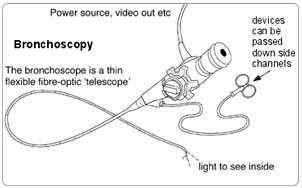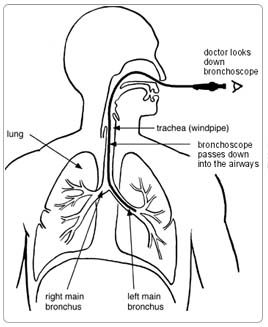What is it?
When you breathe in, the air goes down the windpipe from your Adam's apple down to the back of the middle of your breastbone. There, the windpipe branches into two smaller tubes which carry the air into each of your two lungs. Each of these smaller tubes is called a bronchus.
 Inside the left and right lungs, each bronchus branches again and again to get the air into the depths of the lung. You may have breathed in something like a tooth, a peanut, or a coin. This is called a foreign body. It has stuck in the windpipe or in a bronchus. The air cannot get into your lung properly. This is an emergency and the surgeon needs to look down your windpipe and into each bronchus to find the foreign body and take it out. Alternatively, sometimes lumps swellings or infection in these air tubes cause the same problems. This operation is called a bronchoscopy.
Inside the left and right lungs, each bronchus branches again and again to get the air into the depths of the lung. You may have breathed in something like a tooth, a peanut, or a coin. This is called a foreign body. It has stuck in the windpipe or in a bronchus. The air cannot get into your lung properly. This is an emergency and the surgeon needs to look down your windpipe and into each bronchus to find the foreign body and take it out. Alternatively, sometimes lumps swellings or infection in these air tubes cause the same problems. This operation is called a bronchoscopy.
The Operation
You are likely to have a general anaesthetic and be deeply asleep. The surgeon will pass a flexible telescope into your mouth and down into your windpipe.
 He will have a good look inside the windpipe and inside each bronchus. There is plenty of room in your windpipe around this telescope for air to get in and out of your lungs. If there is a foreign body in your bronchus, the surgeon will pass very small instruments down the telescope to take hold of the foreign body. He will then pull out the foreign body together with the telescope. He may pass very small instruments down the telescope to take tiny snippets from the lining of any area that doesn't look normal. This is called a biopsy. He will send the biopsy to be looked at in the laboratory under a microscope. If it looks as if there is some infection, the surgeon will draw some of the phlegm out of the bronchus through the telescope. He will send the specimens to the laboratory for tests to identify the bugs that are causing the infection. The wound in the lining of the bronchus heals up very quickly. There is no need for any stitches. There are no cuts in the skin.
He will have a good look inside the windpipe and inside each bronchus. There is plenty of room in your windpipe around this telescope for air to get in and out of your lungs. If there is a foreign body in your bronchus, the surgeon will pass very small instruments down the telescope to take hold of the foreign body. He will then pull out the foreign body together with the telescope. He may pass very small instruments down the telescope to take tiny snippets from the lining of any area that doesn't look normal. This is called a biopsy. He will send the biopsy to be looked at in the laboratory under a microscope. If it looks as if there is some infection, the surgeon will draw some of the phlegm out of the bronchus through the telescope. He will send the specimens to the laboratory for tests to identify the bugs that are causing the infection. The wound in the lining of the bronchus heals up very quickly. There is no need for any stitches. There are no cuts in the skin.
Any Alternatives
If you have inhaled a foreign body, it will not come out by waiting or coughing. It may move or cause swelling of the lining of the windpipe or bronchus. Then your air supply to one or both lungs would be cut off. This is very dangerous. X-rays and scans may tell the doctors where the foreign body is, but they are of no use in getting it out. Lasers and shock wave treatment will not work in this situation.
Before the operation
If your case is an emergency, you will be admitted to the ward very quickly. You may even go straight from the Accident and Emergency department to the operating theatre. If you are in a condition that allows you to do so, sort out any tablets, medicines, inhalers that you are using. Keep them in their original boxes and packets. Bring them to the hospital with you. Please tell the doctors and nurses of any allergies to tablets, medicines or dressings. You will have the operation explained to you and will be asked to fill in an operation consent form.
After - In Hospital
It is quite common for patients to have some coughing attacks after the operation. The phlegm may have some streaks of blood in it. It settles down after an hour or so. You will be given some treatment for sickness if necessary. You may be given oxygen from a face mask for a few hours if you have had any chest problems in the past. You will have a slightly sore throat after the operation where the telescope has been rubbing inside the throat. Painkilling tablets should easily control this discomfort. Ask for more if the pain is not well controlled or if it gets worse. A general anaesthetic may make you slow, clumsy and forgetful for about 24 hours. The nurses will help you with everything you need until you are able to do things for yourself. Do not make important decisions during this time. You may be fit to go home the day after your operation. If you have had a foreign body removed, the surgeon will tell you what he found. Usually he can show you the foreign body. He will let you know if any more tests, X-rays, or treatment are needed. Before leaving the ward you will be given an appointment to come back to the outpatient clinic to see the surgeon again for a check-up. If any biopsies have been taken, the surgeon will have the results for you at the clinic. The nurses will advise about sick notes, certificates etc.
After - At Home
Take two painkilling tablets every six hours to control any sore throat.
Possible Complications
As with any operation under general anaesthetic, there is a very small risk of complications related to your heart and lungs. This risk is slightly higher in your situation because your operation is being carried out as an emergency. However, every effort will be made to make sure that you can have the operation in the safest possible way and to minimise the risk for such complications.
If you follow the advice given above, you are unlikely to have any problems. There is a small risk that you may cough up some fresh blood when you are at home. If this is just a spot or two it is not important. If you cough up blood for more than an hour or two (and there is a higher chance that this will happen if many biopsies were taken or if there was difficulty in removing the foreign body), come back to the ward or contact your GP. If you have had a foreign body removed, sometimes the windpipe, the bronchus, or the lung can be damaged by the foreign body and the damaged area can get infected. You will be told about this if it happens. There is also an extremely small possibility that one of the areas from where the biopsies were taken can get infected. If you get an infection, this nearly always gets settled with antibiotics.
Finally, extremely rarely, the telescope or the other instruments that were used during the operation can damage the wind pipe, the bronchus or the lungs (one type of very common and severe damage that can be caused is the creation of a hole/perforation). If this happens you might need another operation to fix the problem.
Advanced Reproductive Technology
- In Vitro Fertilisation (IVF)
- Intracytoplasmic Sperm Injection (ICSI)
- Donor egg and embryo programs
- In Vitro Fertilisation (IVF)
- Pre-implantation genetic diagnosis (PGD)
- Surrogacy programs
Dental Videos





